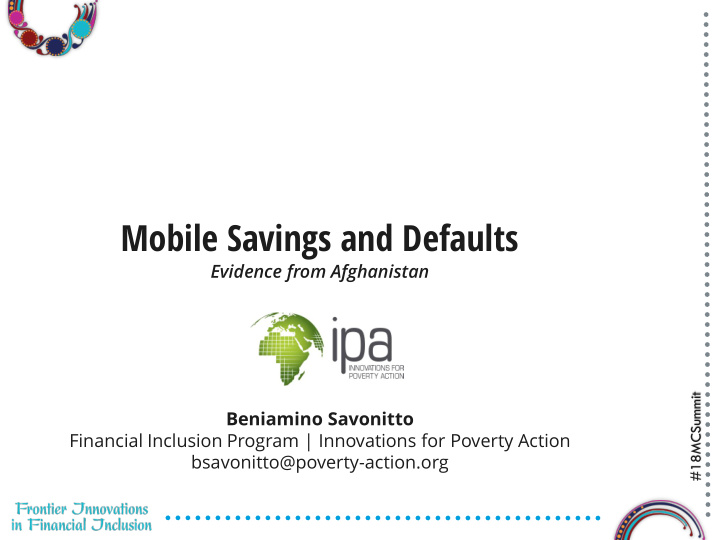



Mobile Savings and Defaults Evidence from Afghanistan #18MCSummit Beniamino Savonitto Financial Inclusion Program | Innovations for Poverty Action bsavonitto@poverty-action.org
Innovations for Poverty Action Discovering & promoting effective solutions to global poverty problems. IPA’s Financial Inclusion Program partners with service providers, governments, and researchers to design and rigorously test financial services and programs encouraging healthy financial behavior among the poor. 130 + projects | 29 countries
Financial Capability The ability to make informed financial decisions and engage in healthy financial behaviors . Financial Skills Improve Learning & Knowledge Colombia Programs Interactive financial education for CCT beneficiaries - tablets Redesign Financial Improve Product Products Information Uganda Financial education vs. savings for youth supported by:
Financial Capability The ability to make informed financial decisions and engage in healthy financial behaviors . Financial Skills Improve Learning & Knowledge Programs Awareness Access to Redesign Financial Improve Product of Products Well-Designed Products Information & Usage Products supported by:
Mobile-izing Savings: Experimental Evidence from the Launch of a “Mobile 401(k)” Plan in Afghanistan Research by: Joshua Blumenstock , University of Washington Michael Callen , Harvard University Tarek Ghani , University of California, Berkeley Research supported by the Bill and Melinda Gates Foundation, Citi Foundation, IMTFI, Roshan and USAID
Context | Afghanistan Limited infrastructure • 9% banked, 30% literacy Low savings • 4% save formally Widespread mobile phones • 40-75% cellular penetration • 4 operators • From 25,000 subscribers in 2002 to 20M+ now Widespread instability, violence, and corruption
Partner | Roshan Largest telecom, 6M+ subscribers Launched M-Paisa in 2008 Became a popular salary disbursement platform
Product Innovation| M-Pasandaz Money-based savings account called “M - Savings” • Secondary mobile money account • basic functionalities (check balance, transfers) • Automatic payroll deduction option • Up to 10% of monthly salary • Allows for matching incentives provided by employer
Product Innovation| M-Pasandaz The fine print • Withdrawals are free and instantaneous • Any withdrawal forfeits all incentives • Incentives paid at end of 6-month “trial” period • Payroll deduction is the only way to deposit to M-Pasandaz • Contribution rate can be changed at any time (takes 2-3 minutes)
Product Innovation| Automatic Deductions Savings is hard. Automatic deductions make it easy, passive . Daily behavioral challenges This study looks at the • Self-control effectiveness of: • Present bias • Inattention Default enrollment in • Procrastination automatic deduction plan • Complexity Incentives to set money aside.
Product Test| Design Launch of M-Pasandaz for 949 employees with monthly salaries disbursed through M-Paisa Lottery assignment to default enrollment and matching contributions
Product Test| Design Savings is hard. default enrollment • No default enrollment Daily behavioral challenges • 5% salary deposited • Self-control (modifiable at any time, up to 10%) • Present bias • Inattention matching contributions • Procrastination • No match • Complexity • 25% match • 50% match (for a 6 months pilot period)
Product Test| Results (1 of 5) Default assignment increases by 40% increase the number of M-Pasandaz savers Default In Default Out 86% 71% *** 56% *** 48% *** 27% *** 1% *** 0% Match 25% Match 50% Match
Product Test| Results (2 of 5) Defaults lead to + 2,500 AFN ($50) contributions in 6 months AFN 10,849 Default In Default Out AFN 8,797 AFN 8,012 ** AFN 5,016 AFN 2,661 *** AFN 417 0% Match 25% Match 50% Match
Product Test| Results (3 of 5) Defaults have a strong effect 46% of employees 46% of employees Roughly with strong incentives with default and no equivalent to and no default still incentives still a 50% match contribute 0% contribute 5%
Product Test| Results (4 of 5) They are not everything of course. Incentives also let to increase in enrollment. Switch back to 0% Switch to 10% Switch to 10%
Product Test| Results (5 of 5) M-Pasandaz increased total Lasting Impact? savings. • Short term study • Avg. participating employee • 45% want to continue saved 37% of monthly salary contribute after match is over • No evidence that employees • Higher for default in group reduced other savings (habit formation?) Financial health Savings Purpose? • + 7 pp increase in employees • 47% hadn’t withdrawn the reporting being good financial money at endline health • Majority is general savings • + 4 pp increase in employees confident that they will meet obligations
Why Do Defaults Work? Defaults are an effective tool to help deal with procrastination and self- control / present-bias. these individuals are less likely to change contribution and to respond to incentives In comparison: SMS Reminders (attention) 2.6% switch in contributions Financial Consultations 11.3% switch in contributions
Conclusion First experimental evaluation of automatic savings Defaults are an effective contributions in a poor country. tool to help deal with procrastination and self- Automatic deductions are an effective means of control / present-bias. stimulating savings. (Particular context but results are consistent with research in advanced economies, eg. 401k.) these individuals are less likely to change contribution and to respond increasing volume of digital payments in the world: to incentives gov’t payments [Chile Banco Estado], agricultural workers [Malawi Tea Estates] Default options – a product / policy design insight. Maintain freedom of decision but effective tool at encouraging a specific behavior [Insurance, product bundles etc.]
Thank you! www.poverty-action.org/financialinclusion bsavonitto@poverty-action.org For more information on the study: Joshua Blumenstock joshblum@uw.edu
Recommend
More recommend